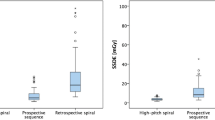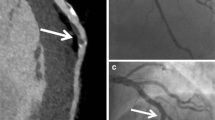Abstract
Background
The usage of coronary CT angiography (CTA) is appropriate in patients with acute or chronic chest pain; however the diagnostic accuracy may be challenged with increased Agatston score (AS), increased heart rate, arrhythmia and severe obesity. Thus, we aim to determine the potential of the recently introduced third-generation dual-source CT (DSCT) for CTA in a ‘real-life’ clinical setting.
Methods
Two hundred and sixty-eight consecutive patients (age: 67 ± 10 years; BMI: 27 ± 5 kg/m²; 61% male) undergoing clinically indicated CTA with DSCT were included in the retrospective single-center analysis. A contrast-enhanced volume dataset was acquired in sequential (SSM) (n = 151) or helical scan mode (HSM) (n = 117). Coronary segments were classified in diagnostic or non-diagnostic image quality. A subset underwent invasive angiography to determine the diagnostic accuracy of CTA.
Results
SSM (96.8 ± 6%) and HSM (97.5 ± 8%) provided no significant differences in the overall diagnostic image quality. However, AS had significant influence on diagnostic image quality exclusively in SSM (B = 0.003; p = 0.0001), but not in HSM. Diagnostic image quality significantly decreased in SSM in patients with AS ≥2,000 (p = 0.03). SSM (sensitivity: 93.9%; specificity: 96.7%; PPV: 88.6%; NPV: 98.3%) and HSM (sensitivity: 97.4%; specificity: 94.3%; PPV: 86.0%; NPV: 99.0%) provided comparable diagnostic accuracy (p = n.s.). SSM yielded significantly lower radiation doses as compared to HSM (2.1 ± 2.0 vs. 5.1 ± 3.3 mSv; p = 0.0001) in age and BMI-matched cohorts.
Conclusion
SSM in third-generation DSCT enables significant dose savings and provides robust diagnostic image quality in patients with AS ≤2000 independent of heart rate, heart rhythm or obesity.



Similar content being viewed by others
Abbreviations
- DSCT:
-
Dual-source CT
- HR:
-
Heart rates
References
Montalescot G, Sechtem U, Achenbach S et al (2013) 2013 ESC guidelines on the management of stable coronary artery disease. Eur Heart J 34:2949–3003. doi:10.1093/eurheartj/eht296
Post F, Gori T, Giannitsis E et al (2015) Criteria of the German Society of Cardiology for the establishment of chest pain units: update 2014. Clin Res Cardiol 104:918–928. doi:10.1007/s00392-015-0888-2
Sinning C, Zengin E, Waldeyer C et al (2016) SYNTAX score-0 patients: risk stratification in nonobstructive coronary artery disease. Clin Res Cardiol 105:901–911. doi:10.1007/s00392-016-0998-5
Abbara S, Arbab-Zadeh A, Callister TQ et al (2009) SCCT guidelines for performance of coronary computed tomographic angiography: a report of the Society of Cardiovascular Computed Tomography Guidelines Committee. J Cardiovasc Comput Tomogr 3:190–204. doi:10.1016/j.jcct.2009.03.004
Abdulla J, Pedersen KS, Budoff M, Kofoed KF (2012) Influence of coronary calcification on the diagnostic accuracy of 64-slice computed tomography coronary angiography: a systematic review and meta-analysis. Int J Cardiovasc Imaging 28:943–953. doi:10.1007/s10554-011-9902-6
Raff GL, Gallagher MJ, O’Neill WW, Goldstein JA (2005) Diagnostic accuracy of noninvasive coronary angiography using 64-slice spiral computed tomography. J Am Coll Cardiol 46:552–557. doi:10.1016/j.jacc.2005.05.056
Scheffel H, Alkadhi H, Plass A et al (2006) Accuracy of dual-source CT coronary angiography: first experience in a high pre-test probability population without heart rate control. Eur Radiol 16:2739–2747. doi:10.1007/s00330-006-0474-0
Alkadhi H, Scheffel H, Desbiolles L et al (2008) Dual-source computed tomography coronary angiography: influence of obesity, calcium load, and heart rate on diagnostic accuracy. Eur Heart J 29:766–776. doi:10.1093/eurheartj/ehn044
Opolski MP, Kim W-K, Liebetrau C et al (2015) Diagnostic accuracy of computed tomography angiography for the detection of coronary artery disease in patients referred for transcatheter aortic valve implantation. Clin Res Cardiol 104:471–480. doi:10.1007/s00392-014-0806-z
Smith SC, Patel MR, Kramer CM et al (2010) ACCF/SCCT/ACR/AHA/ASE/ASNC/NASCI/SCAI/SCMR 2010 appropriate use criteria for cardiac computed tomography. J Cardiovasc Comput Tomogr 4(407):e1–e407.e33. doi:10.1016/j.jcct.2010.11.001
Winklehner A, Goetti R, Baumueller S et al (2011) Automated attenuation-based tube potential selection for thoracoabdominal computed tomography angiography: improved dose effectiveness. Invest Radiol 46:767–773. doi:10.1097/RLI.0b013e3182266448
Layritz C, Muschiol G, Flohr T et al (2013) Automated attenuation-based selection of tube voltage and tube current for coronary CT angiography: reduction of radiation exposure versus a BMI-based strategy with an expert investigator. J Cardiovasc Comput Tomogr 7:303–310. doi:10.1016/j.jcct.2013.08.010
Agatston AS, Janowitz WR, Hildner FJ et al (1990) Quantification of coronary artery calcium using ultrafast computed tomography. J Am Coll Cardiol 15:827–832
Leipsic J, Abbara S, Achenbach S et al (2014) SCCT guidelines for the interpretation and reporting of coronary CT angiography: a report of the Society of Cardiovascular Computed Tomography Guidelines Committee. J Cardiovasc Comput Tomogr 8:342–358. doi:10.1016/j.jcct.2014.07.003
Bischoff B, Hein F, Meyer T, et al (2009) Impact of a reduced tube voltage on CT angiography and radiation dose. JACC Cardiovascular Imaging 2:940–946. doi:10.1016/j.jcmg.2009.02.015
Lee AM, Engel LC, Shah B et al (2012) Coronary computed tomography angiography during arrhythmia: radiation dose reduction with prospectively ECG-triggered axial and retrospectively ECG-gated helical 128-slice dual-source CT. J Cardiovasc Comput Tomogr 6(172–183):e2. doi:10.1016/j.jcct.2012.04.003
Wang Y, Zhang Z, Kong L et al (2008) Dual-source CT coronary angiography in patients with atrial fibrillation: comparison with single-source CT. Eur J Radiol 68:434–441. doi:10.1016/j.ejrad.2008.09.011
Leschka S, Alkadhi H, Plass A et al (2005) Accuracy of MSCT coronary angiography with 64-slice technology: first experience. Eur Heart J 26:1482–1487. doi:10.1093/eurheartj/ehi261
Raff GL, Chinnaiyan KM, Cury RC et al (2014) SCCT guidelines on the use of coronary computed tomographic angiography for patients presenting with acute chest pain to the emergency department: a report of the Society of Cardiovascular Computed Tomography Guidelines Committee. J Cardiovasc Comput Tomogr 8:254–271. doi:10.1016/j.jcct.2014.06.002
Scheffel H, Alkadhi H, Leschka S et al (2008) Low-dose CT coronary angiography in the step-and-shoot mode: diagnostic performance. Heart 94:1132–1137. doi:10.1136/hrt.2008.149971
Hosch W, Heye T, Schulz F et al (2011) Image quality and radiation dose in 256-slice cardiac computed tomography: comparison of prospective versus retrospective image acquisition protocols. Eur J Radiol 80:127–135. doi:10.1016/j.ejrad.2010.07.011
Deseive S, Pugliese F, Meave A et al (2015) Image quality and radiation dose of a prospectively electrocardiography-triggered high-pitch data acquisition strategy for coronary CT angiography: the multicenter, randomized PROTECTION IV study. J Cardiovasc Comput Tomogr 9:278–285. doi:10.1016/j.jcct.2015.03.001
Earls JP, Berman EL, Urban BA et al (2008) Prospectively gated transverse coronary CT angiography versus retrospectively gated helical technique: improved image quality and reduced radiation dose. Radiology 246:742–753. doi:10.1148/radiol.2463070989
Li M, Zhang G-M, Zhao J-S et al (2014) Diagnostic performance of dual-source CT coronary angiography with and without heart rate control: systematic review and meta-analysis. Clin Radiol 69:163–171. doi:10.1016/j.crad.2013.09.008
Seiffert M, Ojeda F, Müllerleile K et al (2015) Reducing radiation exposure during invasive coronary angiography and percutaneous coronary interventions implementing a simple four-step protocol. Clin Res Cardiol 104:1–7. doi:10.1007/s00392-015-0814-7
Author information
Authors and Affiliations
Corresponding author
Ethics declarations
Conflict of interest
On behalf of all authors, the corresponding author states that there is no conflict of interest.
Rights and permissions
About this article
Cite this article
Ochs, M.M., Siepen, F.a.d., Fritz, T. et al. Limits of the possible: diagnostic image quality in coronary angiography with third-generation dual-source CT. Clin Res Cardiol 106, 485–492 (2017). https://doi.org/10.1007/s00392-017-1077-2
Received:
Accepted:
Published:
Issue Date:
DOI: https://doi.org/10.1007/s00392-017-1077-2




